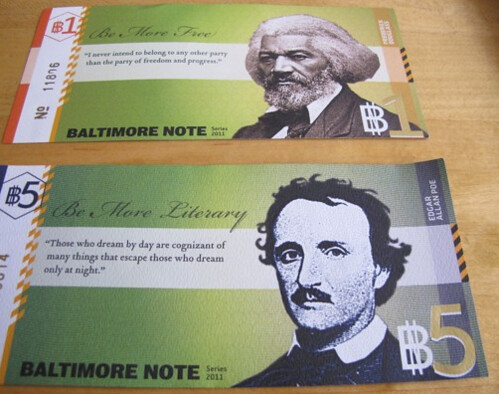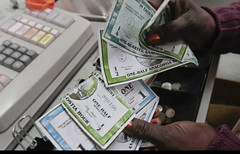
PREV ARTICLE
NEXT ARTICLE
FULL ISSUE
PREV FULL ISSUE
WASHINGTON POST ARTICLE ON LOCAL CURRENCY
Tuesday morning I spotted an interesting article in The Washington Post about alternative currencies in the greater Baltimore-Washington D.C. area. Here's an excerpt.
-Editor
After the cashier rang up his purchases, he pulled out a funny-looking piece of paper instead of a wad of cash. The bill had environmentalist Rachel Carson’s picture where Abraham Lincoln’s ought to have been. Stripped across the top was the motto “In Each Other We Trust.” Monopoly money? No, just a local currency system in the Mount Rainier and Hyattsville neighborhoods in Prince George’s County, where users essentially trade goods and services using money the group designed and printed called “Anacostia Hours.” Local or alternative currencies are almost as old as trade itself, but the movement has found new life amid the global financial crisis, as parallel economies outside the traditional monetary system have emerged in countries such as Spain, Mexico and Brazil. These systems are flourishing because the unemployed can either trade skills for local currency or swap their time for other services. Supporters of local currency in the United States say they are founding these systems here because they believe in the “buy local” movement and want to strengthen their neighborhoods and reduce reliance on large corporate banks. “Obviously the idea of local currency has been around for a long time and historically they do pop up in times of economic uncertainty,” said Julie Gouldener, 40, program coordinator of the Baltimore Green Currency Association. “We view the complementary currency as a win-win. It’s not meant to replace the U.S. dollar. It’s meant to exist alongside it and build more local wealth.” Gouldener’s group launched a currency called the BNote in April 2011. Locals can trade real dollars for BNotes at eight “cambios” around the city, including Zeke’s Coffee in Northeast Baltimore, and use them at 175 businesses. So far, there are about 28,000 BNotes in circulation. Collom said that currency systems are more likely to falter because organizers find it difficult to sustain momentum. Even the Ithaca Hours has seen a decline in usage, with the number of participating businesses falling from about 500 at its height to about 200 now. Its new board president, Paul Strebel, a financial adviser, said he hopes to reinvigorate the system and is exploring using virtual bills on smartphones. Feeling like he needed to do something to help in the country’s economic downturn, District artist Larry Chang, 63, began making local money he called Potomacs in 2009, currency that eventually was accepted in places such as Qualia Coffee in Petworth. But after a good start, the movement lost steam, Chang said. “It hasn’t caught on very well,” he said. “In D.C. it was very hard to put something across that’s alternative.” In the neighborhoods surrounding Mount Rainier, however, the Anacostia Hours program has been a small but steady presence since it was founded in 2006. There are now 76 members, who pay $5 each in annual dues and provide everything from yardwork to pet-sitting to nutritional consulting, Williams said.

To read the complete article, see:
Monopoly money? Nope, just local currency
(www.washingtonpost.com/local/monopoly-money-nope-just-local-currency The Numismatic Bibliomania Society is a non-profit organization promoting numismatic literature. See our web site at coinbooks.org. To submit items for publication in The E-Sylum, write to the Editor at this address: whomren@gmail.com To subscribe go to: https://my.binhost.com/lists/listinfo/esylum All Rights Reserved. NBS Home Page Contact the NBS webmaster 
|
